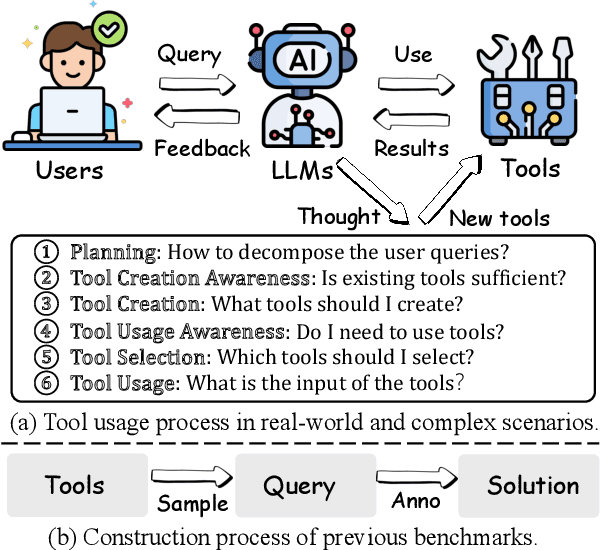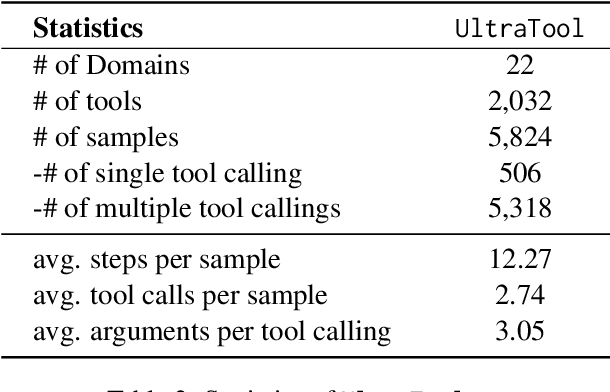Shijue Huang
UI-TARS: Pioneering Automated GUI Interaction with Native Agents
Jan 21, 2025Abstract:This paper introduces UI-TARS, a native GUI agent model that solely perceives the screenshots as input and performs human-like interactions (e.g., keyboard and mouse operations). Unlike prevailing agent frameworks that depend on heavily wrapped commercial models (e.g., GPT-4o) with expert-crafted prompts and workflows, UI-TARS is an end-to-end model that outperforms these sophisticated frameworks. Experiments demonstrate its superior performance: UI-TARS achieves SOTA performance in 10+ GUI agent benchmarks evaluating perception, grounding, and GUI task execution. Notably, in the OSWorld benchmark, UI-TARS achieves scores of 24.6 with 50 steps and 22.7 with 15 steps, outperforming Claude (22.0 and 14.9 respectively). In AndroidWorld, UI-TARS achieves 46.6, surpassing GPT-4o (34.5). UI-TARS incorporates several key innovations: (1) Enhanced Perception: leveraging a large-scale dataset of GUI screenshots for context-aware understanding of UI elements and precise captioning; (2) Unified Action Modeling, which standardizes actions into a unified space across platforms and achieves precise grounding and interaction through large-scale action traces; (3) System-2 Reasoning, which incorporates deliberate reasoning into multi-step decision making, involving multiple reasoning patterns such as task decomposition, reflection thinking, milestone recognition, etc. (4) Iterative Training with Reflective Online Traces, which addresses the data bottleneck by automatically collecting, filtering, and reflectively refining new interaction traces on hundreds of virtual machines. Through iterative training and reflection tuning, UI-TARS continuously learns from its mistakes and adapts to unforeseen situations with minimal human intervention. We also analyze the evolution path of GUI agents to guide the further development of this domain.
CroPrompt: Cross-task Interactive Prompting for Zero-shot Spoken Language Understanding
Jun 15, 2024Abstract:Slot filling and intent detection are two highly correlated tasks in spoken language understanding (SLU). Recent SLU research attempts to explore zero-shot prompting techniques in large language models to alleviate the data scarcity problem. Nevertheless, the existing prompting work ignores the cross-task interaction information for SLU, which leads to sub-optimal performance. To solve this problem, we present the pioneering work of Cross-task Interactive Prompting (CroPrompt) for SLU, which enables the model to interactively leverage the information exchange across the correlated tasks in SLU. Additionally, we further introduce a multi-task self-consistency mechanism to mitigate the error propagation caused by the intent information injection. We conduct extensive experiments on the standard SLU benchmark and the results reveal that CroPrompt consistently outperforms the existing prompting approaches. In addition, the multi-task self-consistency mechanism can effectively ease the error propagation issue, thereby enhancing the performance. We hope this work can inspire more research on cross-task prompting for SLU.
CLongEval: A Chinese Benchmark for Evaluating Long-Context Large Language Models
Mar 06, 2024Abstract:Developing Large Language Models (LLMs) with robust long-context capabilities has been the recent research focus, resulting in the emergence of long-context LLMs proficient in Chinese. However, the evaluation of these models remains underdeveloped due to a lack of benchmarks. To address this gap, we present CLongEval, a comprehensive Chinese benchmark for evaluating long-context LLMs. CLongEval is characterized by three key features: (1) Sufficient data volume, comprising 7 distinct tasks and 7,267 examples; (2) Broad applicability, accommodating to models with context windows size from 1K to 100K; (3) High quality, with over 2,000 manually annotated question-answer pairs in addition to the automatically constructed labels. With CLongEval, we undertake a comprehensive assessment of 6 open-source long-context LLMs and 2 leading commercial counterparts that feature both long-context abilities and proficiency in Chinese. We also provide in-depth analysis based on the empirical results, trying to shed light on the critical capabilities that present challenges in long-context settings. The dataset, evaluation scripts, and model outputs will be released.
Planning, Creation, Usage: Benchmarking LLMs for Comprehensive Tool Utilization in Real-World Complex Scenarios
Jan 30, 2024



Abstract:The recent trend of using Large Language Models (LLMs) as intelligent agents in real-world applications underscores the necessity for comprehensive evaluations of their capabilities, particularly in complex scenarios involving planning, creating, and using tools. However, existing benchmarks typically focus on simple synthesized queries that do not reflect real-world complexity, thereby offering limited perspectives in evaluating tool utilization. To address this issue, we present UltraTool, a novel benchmark designed to improve and evaluate LLMs' ability in tool utilization within real-world scenarios. UltraTool focuses on the entire process of using tools - from planning and creating to applying them in complex tasks. It emphasizes real-world complexities, demanding accurate, multi-step planning for effective problem-solving. A key feature of UltraTool is its independent evaluation of planning with natural language, which happens before tool usage and simplifies the task solving by mapping out the intermediate steps. Thus, unlike previous work, it eliminates the restriction of pre-defined toolset during planning. Through extensive experiments on various LLMs, we offer novel insights into the evaluation of capabilities of LLMs in tool utilization, thereby contributing a fresh perspective to this rapidly evolving field. The benchmark is publicly available at https://github.com/JoeYing1019/UltraTool.
SDIF-DA: A Shallow-to-Deep Interaction Framework with Data Augmentation for Multi-modal Intent Detection
Dec 31, 2023Abstract:Multi-modal intent detection aims to utilize various modalities to understand the user's intentions, which is essential for the deployment of dialogue systems in real-world scenarios. The two core challenges for multi-modal intent detection are (1) how to effectively align and fuse different features of modalities and (2) the limited labeled multi-modal intent training data. In this work, we introduce a shallow-to-deep interaction framework with data augmentation (SDIF-DA) to address the above challenges. Firstly, SDIF-DA leverages a shallow-to-deep interaction module to progressively and effectively align and fuse features across text, video, and audio modalities. Secondly, we propose a ChatGPT-based data augmentation approach to automatically augment sufficient training data. Experimental results demonstrate that SDIF-DA can effectively align and fuse multi-modal features by achieving state-of-the-art performance. In addition, extensive analyses show that the introduced data augmentation approach can successfully distill knowledge from the large language model.
Cross-lingual Prompting: Improving Zero-shot Chain-of-Thought Reasoning across Languages
Oct 23, 2023Abstract:Chain-of-thought (CoT) is capable of eliciting models to explicitly generate reasoning paths, thus promoting reasoning accuracy and attracting increasing attention. Specifically, zero-shot CoT achieves remarkable improvements in a wide range of reasoning tasks by simply instructing the LLM with the prompt "Let's think step by step!". Despite the success of zero-shot CoT, the existing zero-shot prompting techniques remain limited to a single language, making it challenging to generalize to other languages and hindering global development. In this work, we introduce cross-lingual prompting (CLP), aiming to improve zero-shot CoT reasoning across languages. Specifically, CLP consists of two main components: (1) cross-lingual alignment prompting and (2) task-specific solver prompting. The cross-lingual alignment prompting is responsible for aligning representations across different languages, whereas the task-specific solver prompting is used to generate the final chain of thoughts and results for the reasoning task. In addition, we further introduce cross-lingual self-consistent prompting (CLSP) to ensemble different reasoning paths across languages. Our experimental evaluations on several benchmarks demonstrate that CLP and CLSP significantly outperform the existing prompting methods and achieve state-of-the-art performance. We hope this work will inspire further breakthroughs in cross-lingual CoT.
Improving Few-shot and Zero-shot Entity Linking with Coarse-to-Fine Lexicon-based Retriever
Aug 13, 2023Abstract:Few-shot and zero-shot entity linking focus on the tail and emerging entities, which are more challenging but closer to real-world scenarios. The mainstream method is the ''retrieve and rerank'' two-stage framework. In this paper, we propose a coarse-to-fine lexicon-based retriever to retrieve entity candidates in an effective manner, which operates in two layers. The first layer retrieves coarse-grained candidates by leveraging entity names, while the second layer narrows down the search to fine-grained candidates within the coarse-grained ones. In addition, this second layer utilizes entity descriptions to effectively disambiguate tail or new entities that share names with existing popular entities. Experimental results indicate that our approach can obtain superior performance without requiring extensive finetuning in the retrieval stage. Notably, our approach ranks the 1st in NLPCC 2023 Shared Task 6 on Chinese Few-shot and Zero-shot Entity Linking.
MMSD2.0: Towards a Reliable Multi-modal Sarcasm Detection System
Jul 14, 2023



Abstract:Multi-modal sarcasm detection has attracted much recent attention. Nevertheless, the existing benchmark (MMSD) has some shortcomings that hinder the development of reliable multi-modal sarcasm detection system: (1) There are some spurious cues in MMSD, leading to the model bias learning; (2) The negative samples in MMSD are not always reasonable. To solve the aforementioned issues, we introduce MMSD2.0, a correction dataset that fixes the shortcomings of MMSD, by removing the spurious cues and re-annotating the unreasonable samples. Meanwhile, we present a novel framework called multi-view CLIP that is capable of leveraging multi-grained cues from multiple perspectives (i.e., text, image, and text-image interaction view) for multi-modal sarcasm detection. Extensive experiments show that MMSD2.0 is a valuable benchmark for building reliable multi-modal sarcasm detection systems and multi-view CLIP can significantly outperform the previous best baselines.
Don't be Contradicted with Anything! CI-ToD: Towards Benchmarking Consistency for Task-oriented Dialogue System
Sep 23, 2021



Abstract:Consistency Identification has obtained remarkable success on open-domain dialogue, which can be used for preventing inconsistent response generation. However, in contrast to the rapid development in open-domain dialogue, few efforts have been made to the task-oriented dialogue direction. In this paper, we argue that consistency problem is more urgent in task-oriented domain. To facilitate the research, we introduce CI-ToD, a novel dataset for Consistency Identification in Task-oriented Dialog system. In addition, we not only annotate the single label to enable the model to judge whether the system response is contradictory, but also provide more fine-grained labels (i.e., Dialogue History Inconsistency, User Query Inconsistency and Knowledge Base Inconsistency) to encourage model to know what inconsistent sources lead to it. Empirical results show that state-of-the-art methods only achieve 51.3%, which is far behind the human performance of 93.2%, indicating that there is ample room for improving consistency identification ability. Finally, we conduct exhaustive experiments and qualitative analysis to comprehend key challenges and provide guidance for future directions. All datasets and models are publicly available at \url{https://github.com/yizhen20133868/CI-ToD}.
 Add to Chrome
Add to Chrome Add to Firefox
Add to Firefox Add to Edge
Add to Edge